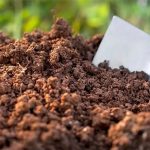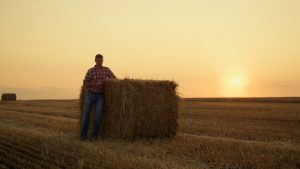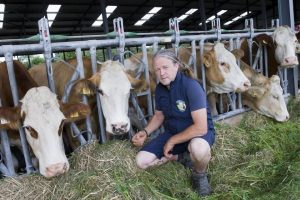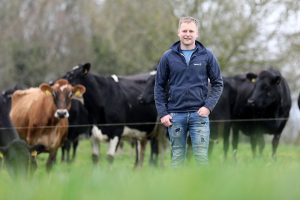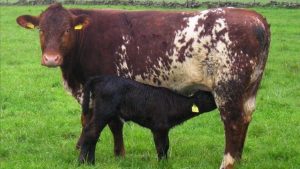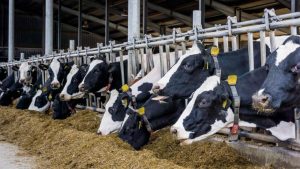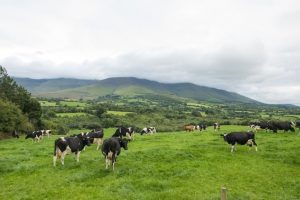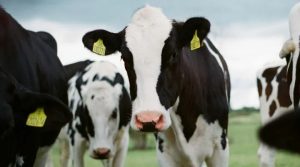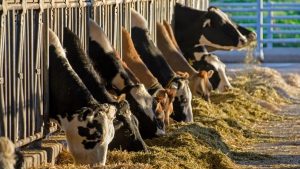
In Northern Ireland, traditionally, a lot of the herds would be high yielding cows being milked on a total mixed ration (TMR) and fully indoors, but can these high yielding cows be grazed successfully?
This year may be a poor year to benchmark off, considering the poor weather at the start of the spring, which made it difficult to get cows out grazing.
The unsettled and poor weather conditions continued throughout the summer months, with grass growth taking a major hit.
For many people, getting cows out to grass and managing them during the grazing season sounds like a lot of hard work, when in reality, you can simply keep the cows in the house on a consistent diet, with each day being the same.
However, the Murray family proved that high yielding herds be grazed successfully when the College of Agriculture, Food and Rural Enterprise’s (CAFRE) dairying development specialist, Michael Verner, analysed their system.
High yielding cows
Andrew Murray, along with his father David, runs a Holstein/Friesian herd on a grass only farm near Ballyroney, Co. Down.
The rolling performance figures of the herd are 8455L sold/cow/year, with 3498L of milk from forage and a concentrate input of 2.2t/cow/year.
Like many herds, turnout was delayed until April 28, with cows out by day and night only a week later. The herd is tight autumn calving and currently averages 270 days in milk, with a third of the herd already dried off.

Current performance is 24.5 L/cow/day, at 4.25% butterfat and 3.60% protein, from 3.75kg of a 16% protein concentrate, meaning 15L of milk is being produced from grazed grass.
Regular reseeding is carried out to ensure cows are always presented with top quality grass, or in the winter months, grass silage.
Grass to milk
Andrew said that DM intakes are key to achieving high levels of performance, and so cows are given access to fresh grass after each milking, and normally would be going into covers of 3,400kg DM/ha and coming out leaving a residual of 2,000kg DM/ha (6cm).
The pre-grazing cover of 3,400kg DM/ha would equate to about 1,700 kg DM/ha in the Republic of Ireland’s system of grass measuring.
Pre mowing is practiced to again encourage DM intake. It is not just cows which have access to quality grass, as 2023-born calves are grazing young leafy swards full time with 0.5 – 0.75kg of concentrate supplementation.
In-calf heifers are likewise grazing full-time on a grass only diet.
The farm has a rolling replacement rate of 22%, with heifers calving in at 24 months and cull cows leaving the herd having achieved an average lifetime performance of 43,150L of milk.
Andrew feels that in order to have an efficient sustainable dairy business, he needs a cow which produces quality milk (high solids), has the ability to consume large amounts of both grazed and conserved forage, has good fertility and lasts within his herd.
In recent years, some Friesian semen has been introduced, with 75% Holstein and 25% Friesian heifers currently part of the system.
The cows are currently performing very well in the herd. Bulls such as Westcoast Almamater, Bomaz Fynn, Seagull Bay Applejax and Bomaz Vader have been used recently.
Verner made the point that, while all is well and good getting cows grazing successfully, “what about the cost?”.
“Can you afford to not to be making the best use of the best quality feed on your farm which is the cheapest feed on your farm?,” he asked.
According to CAFRE, a herd of 100 cows at grass full-time, could possibly save you £120/day in diet costs compared to a similarly sized housed herd.
According to Teagasc, every extra day at grass is important to maximise milk solids production, which will increase milk price received as every day at grass in the autumn is worth approximately €2/head, so it all adds up.
You can now read the most important #news on #eDairyNews #Whatsapp channels!!!
🇺🇸 eDairy News INGLÊS: https://whatsapp.com/channel/0029VaKsjzGDTkJyIN6hcP1K


